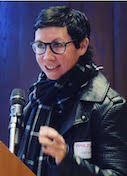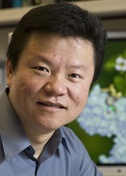All Who Wander Are Not Lost
Frank Delaglio
Agilent Technologies
Published February 24, 2014
Frank Delaglio knew he wanted a career in biomedical research at age 7, in 1968, when he saw his baby brother in an incubator being prepared for open heart surgery. Today, he is one of the go-to software experts in nuclear magnetic resonance (NMR), having designed or contributed significantly to the field's key software tools, such as NMRPipe and TALOS. But the path he took to get to this point — and to the point of having a direct impact on biomedicine — was circuitous and long, driven in equal parts by luck and preparation.
Delaglio landed his first job in a crystallography lab as a chemistry undergraduate at Syracuse University because he had some experience developing film. In that lab, he ended up producing software for analyzing small angle X-ray scattering data and published five papers, one as first author, on numerical methods and mathematical modeling.
What he did not produce, however, was a degree. Instead, Delaglio left the lab for a full-time software job in a newly established and very well funded NMR lab. At that time, in the early 1980s, two-dimensional NMR was just emerging, as were minicomputers, so the demand for numerical analysis software for NMR was on the rise. "It seemed that every week people were designing new NMR experiments that revealed something different about molecular structure," he says. "It was pretty exciting."
That laboratory's software work spun off as a startup, taking Delaglio with it to help produce and commercialize their 2D NMR product called NMR2. Delaglio looks back on these years spent working outside of the realm of academic science as tremendously valuable. "I constantly had to demonstrate my work to convince people it had value and I had to learn to communicate with clients to figure out how to serve them," he says.
In fact, that ability to communicate helped Delaglio score his next position, a coveted role on staff at the National Institutes of Health in the lab of Ad Bax, an NMR pioneer. During a commercial visit to the Bax lab, Delaglio impressed them so much that they hired him. "It's one of the moments of my career that I'm most proud of," he says.
At the NIH, Delaglio spent his time designing a new kind of software to support NMR. "I needed to make something flexible and extensible, with a clearly understandable framework," says Delaglio, who settled on a modular design built on the concept of UNIX pipes, aptly named NMRPipe and first released in 1995.
During this time, Delaglio was living the life of an academic, yet he'd never finished his degrees. When Professor Yuji Kobayashi of Osaka University heard this news — while sitting outdoors in a hot tub at a scientific conference, as Delaglio recalls — he exclaimed: "Frank-san, come have a PhD in my lab!"
A year and a half later, at the age of 40, Delaglio was awarded his bachelor's degree from Syracuse and his PhD from Osaka. "These things, they just fell into my lap," he says, not just of the degrees, but of his entire career.
Today, Delaglio works for Agilent Technologies designing NMR solutions for research. "I can see all the parts of NMR spectroscopy translated into the practice of clinical medicine," he says. "So my dream career only took 30 years to actually happen."
- Elizabeth Dougherty



























































































